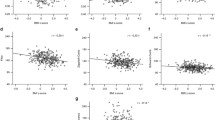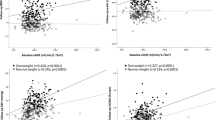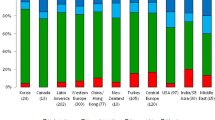Abstract
This study investigates the changing referral patterns of young patients to a tertiary pediatric nephrology center with a well-defined catchment area over two consecutive 8.5-year periods. We paid special attention to the known increase of obesity and diabetes mellitus in childhood. Demographic data (site of residence, height, weight, gender and renal diagnosis) were collected on 6,154 children aged 0–19 years, referred as in- and outpatients to the Children’s Hospital of Eastern Ontario for nephrological work-up. Body mass index (BMI) Z-scores were calculated on the basis of data from the National (USA) Center for Health Statistics (2000). In 6,124 (99.5%) patients a final renal diagnosis could be made, allowing calculation of the incidence of a variety of renal diseases in pediatric patients, data that are not readily available. BMI increased significantly over the years, with a Z-score that rose from a median of +0.20 to +0.32 in the two 8.5-year study periods (p<0.0001). The increase in obesity coincided with a significant increase in the incidence of chronic renal insufficiency (CRI). The combined incidence of CRI and end stage renal disease rose from 0.994 to 2.334 per 100,000 children per year (p=0.0014). This study provides new information on the (changing) pattern of pediatric renal disease over almost two decades. Pediatric renal patients became progressively overweight and showed an increase in the incidence of CRI. This is the first time that this phenomenon, well known in adults, has been observed in the pediatric age group.


Similar content being viewed by others
References
International Study of Kidney Disease in Children (1978) Nephrotic syndrome in children: prediction of histopathology from clinical and laboratory characteristics at time of diagnosis. Kidney Int 13:159–165
Srivastava T, Simon ST, Alon US (1999) High incidence of focal segmental glomerulosclerosis in nephrotic syndrome of childhood. Pediatr Nephrol 13:13–18
Bonilla-Felix M, Parra C, Dajani T, Ferris M, Swinford RD, Portman RJ, Verani R (1999) Changing patterns in the histopathology of idiopathic nephrotic syndrome in children. Kidney Int 55:1885–1890
Filler G, Young E, Geier P, Carpenter B, Drukker A, Feber J (2003) Is there really an increase in non-minimal change nephrotic syndrome in children? Am J Kidney Dis 42:1107–1113
Kimm SY, Obarzanek E (2002) Childhood obesity: a new pandemic of the new millennium. Pediatrics 110:1003–1007
EURODIAB ACE Study Group (2000) Wide variability and increasing incidence of childhood diabetes in Europe. Lancet 355:873–876
CDC (2000) Growth charts for the United States. Centers for Disease Control and Prevention, Atlanta, GA (see http://www.cdc.gov/growthcharts/)
Statistics Canada (2005) 2001 Census of Canada website. Statistics Canada, Ottawa, Canada (see http://www12.statcan.ca/english/census01/)
Foreman JW, Chan JC (1990) 10-year survey of referrals to a pediatric nephrology program. Child Nephrol Urol 10:8–13
Orta-Sibu N, Lopez M, Moriyon JC, Chavez JB (2002) Renal diseases in children in Venezuela, South America. Pediatr Nephrol 17:566–569
Rowe PC, Orrbine E, Lior H, Wells GA, McLaine PN (1993) A prospective study of exposure to verotoxin-producing Escherichia coli among Canadian children with haemolytic uraemic syndrome. The CPKDRC co-investigators. Epidemiol Infect 110:1–7
Ardissino G, Dacco V, Testa S, Bonaudo R, Claris-Appiani A, Taioli E, Marra G, Edefonti A, Sereni F (2003) Epidemiology of chronic renal failure in children: data from the ItalKid project. Pediatrics 111:E382–387
Friedman AN, Miskulin DC, Rosenberg IH, Levey AS (2003) Demographics and trends in overweight and obesity in patients at time of kidney transplantation. Am J Kidney Dis 41:480–487
Eknoyan G, Levey AS, Levin NW, Keane WF (2001) The national epidemic of chronic kidney disease. What we know and what we can do. Postgrad Med 110:23–29
Mokdad AH, Ford ES, Bowman BA, Dietz WH, Vinicor F, Bales VS, Marks JS (2003) Prevalence of obesity, diabetes, and obesity-related health risk factors, 2001. JAMA 289:76–9
Young EW (1997) An improved understanding of the causes of end-stage renal disease. Semin Nephrol 17:170–175
Sinha R, Fisch G, Teague B, Tamborlane WV, Banyas B, Allen K, Savoye M, Rieger V, Taksali S, Barbetta G, Sherwin RS, Caprio S (2002) Prevalence of impaired glucose tolerance among children and adolescents with marked obesity. N Engl J Med 346:802–810
EURODIAB ACE Study Group (2000) Variation and trends in incidence of childhood diabetes in Europe. Lancet 355(9207):873–876
Drummond K, Mauer M (2002) The early natural history of nephropathy in type 1 diabetes: II. Early renal structural changes in type 1 diabetes. Diabetes 51:1580–1587
Williams PT, Fortmann SP, Terry RB, Garay SC, Vranizan KM, Ellsworth N, Wood PD (1987) Associations of dietary fat, regional adiposity, and blood pressure in men. JAMA 257:3251–3256
Ebbeling CB, Pawlak DB, Ludwig DS (2002) Childhood obesity: public-health crisis, common sense cure. Lancet 360(9331):473–482
Hattersley AT, Tooke JE (1999) The fetal insulin hypothesis: an alternative explanation of the association of low birthweight with diabetes and vascular disease. Lancet 353(9166):1789–1792
Acknowledgements
We express our gratitude to all other pediatric nephrologists (Dr. Norman Wolfish, Dr. Janusz Feber and Dr. Gabrielle Weiler), and the fellows and residents at CHEO who filled the data collection documents. We thank Darlene Poulin for her valuable editing of the English language and David Moher for his important discussions on the statistical evaluation of the data. The study was funded by grants to Peter McLaine and Guido Filler by the CHEO Research Institute.
Author information
Authors and Affiliations
Corresponding author
Rights and permissions
About this article
Cite this article
Filler, G., Payne, R.P., Orrbine, E. et al. Changing trends in the referral patterns of pediatric nephrology patients. Pediatr Nephrol 20, 603–608 (2005). https://doi.org/10.1007/s00467-004-1750-3
Received:
Revised:
Accepted:
Published:
Issue Date:
DOI: https://doi.org/10.1007/s00467-004-1750-3




